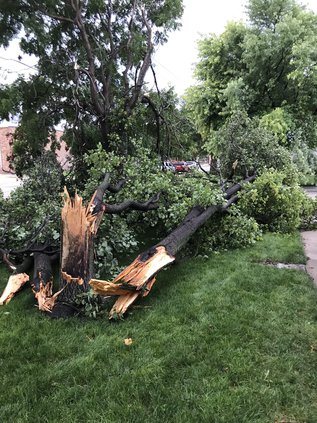Storms may cause serious tree damage. Often you will have to decide whether a tree can be saved or not. Here is a checklist on care of a storm-damaged landscape.
1. Don’t venture under the tree until it is safe. If large limbs are hanging precariously, a certified arborist has the tools, training and knowledge to do the work safely.
2. Cleanup: Remove debris so you don’t trip over it.
3. Decide whether it is feasible to save a tree. If the bark has been split so the cambium is exposed or the main trunk split, the tree probably will not survive and should be removed. If there are so many broken limbs that the tree’s form is destroyed, replacement is the best option. Topping, where all the main branches will normally arise from the stubs left, is not a recommended pruning procedure. Though new branches will normally arise from the stubs, they are not as firmly attached as the original branches and more likely to break in subsequent storms. Also, the tree must use a lot of energy to develop new branches, leaving less to fight off diseases and insect attacks. Often the topped tree’s life shortened.
4. Prune broken branches to the next larger branch or to the trunk. If cutting back to the trunk, do not cut flush with the trunk but rather at the collar area between the branch and the trunk but rather at the collar area between the branch and the trunk. Cutting flush with the trunk leaves a much larger wound than cutting at the collar and takes longer to heal. Middle-aged or younger vigorous trees can have larger wound than cutting at the collar and takes longer to heal. Middle-aged or younger vigorous trees can have up to one-third of the crown removal and still make a surprisingly swift comeback.
5. Take large limbs off in stages. If you try to take off a large limb in one cut, it will often break before the cut is finished and strip bark from the tree. Instead, first make a cut about 15 inches from the trunk. Start from the bottom and cut one-third of the way up through the limb. Make the second cut from the top down but start 2 inches further away from the trunk than the first. The branch will break away as you make the second cut. The third cut, made a the collar area, removes the stub that is left.
Note: Pruning can be dangerous. Consider hiring a trained, certified arborist to do major work. Also, a good arborist knows how how to prune trees so that storm breakage is less likely to occur. Preventing damage is better than trying to fix it once it has happened.
If you have questions please contact your local Extension Office.”
Lauren Walz is the K-State Research & Extension Cottonwood District horticulture agent. She can be reached at laurenwalz16@ksu.edu.





